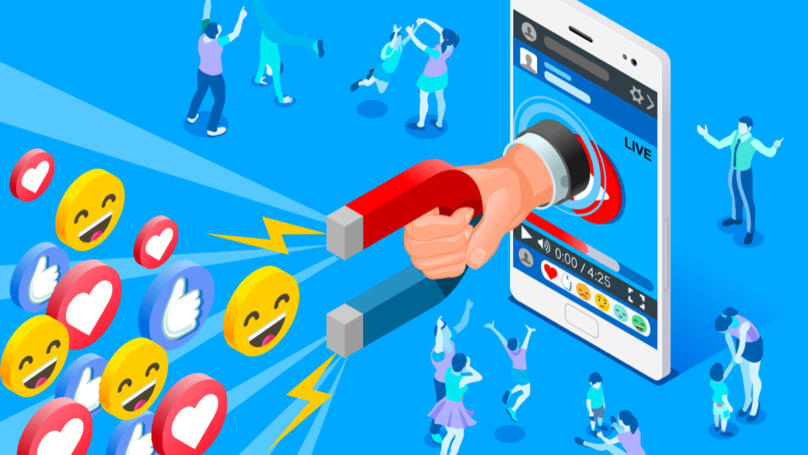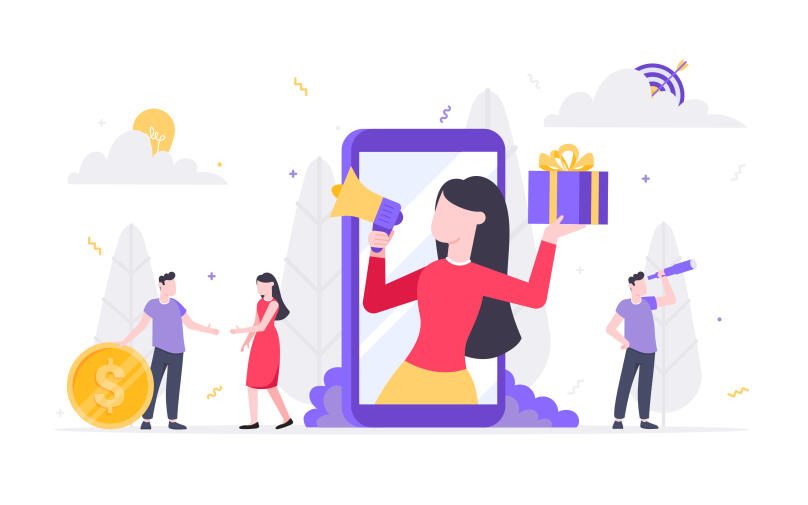Influencer
What is an influencer?

An Influencer is a person who enjoys authority in society due to their popularity in a certain niche. What does the influencer mean in the context of terminology? The term itself originates from the English word "influence" which means "to have the power to affect the way someone thinks". Another term for the influencers is "opinion leaders".
When answering the question "Who are the influenсers and what are they needed for?", it is important to understand that it is all about brands and their image. Without influencers, brands could not form it. Audiences are beginning to trust new products and companies thanks to the influencers. In simple words, the influencers form public opinion and set trends. This is why influence marketing - a separate type of marketing focused on working with influencers - has appeared.
Who are social media influencers
A social media influencer is a person who enjoys authority on a particular internet platform due to the large-size audience attracted. They are also called "virtual influencers" or "digital influencers". Therefore, any blogger who has an audience and specialises in a certain subject is a potential influencer. Influencers on social media regularly publish thematic or useful content, interact with their followers, attract new ones, engage in collaborations (partnerships) with other bloggers and conduct promotional activities.
Types of influencers

Influencers can be classified by the size of their audience:
- Influencers followed by over one million subscribers (the most expensive ones);
- macro-influencers who have from 50 000 to a million subscribers;
- micro-influencers - 10 000 - 50 000 subscribers;
- nano-influencers - 1000 - 10 000 subscribers (the most budget ones).
Influencers can also be classified as follows:
- Bloggers. They are people actively developing their social media accounts in order to attract an audience. Most popular niches:
- Fashion bloggers. They specialize in content dedicated to style and fashion trends . Clothing, accessories and perfume brands are most commonly advertised. A good example is a fashion influencer and model Caroline Daur. In her blog, she focuses on covering fashion trends.
- Beauty bloggers. These cover all topics about cosmetics and beauty products including makeup, toilet, hairdressing, etc. Typically, such bloggers advertise beauty brands. For example, beauty influencer Anastasia Smirnova, has devoted her blog to make up.
- Travel bloggers. They specialize in tourism. The content covers travelling including the cultures of various countries. Often the feature of these blogs is high-quality visual content. They advertise, as a rule, equipment, hiking products, hotels, etc. For example, Brooke Savard who explores different corners of the world.
- Lifestyle bloggers. They demonstrate a specific lifestyle, share their life hacks, thoughts, and help instill certain habits in the audience. They mostly promote the brands that relate to their life-concept: food, brands, digital technologies, gadgets, or cosmetics. For example, Inna Mishka leads her blog in the Scandinavian style.
- Food bloggers. These bloggers specialize in cooking dishes (recipes) or tastings or restaurant business issues. They advertise food and restaurants. For example, Nicholay Mangaloid.
- Fitness bloggers. They write about healthy lifestyle, sports, exercise, fitness, and health. Typically they advertise supplements, vitamins, food products. For example, coach Amanda Bisk.
- Celebrities. Actors, models, singers, journalists, etc. people who are known not only on social media by their blog, but also can often be seen in the media, and are also part of a certain "elite."
- Creators. Creative people who generate content or products. This group includes artists, designers, musicians, writers, etc. A creator can also be a celebrity.
- Experts. Professionals known in a certain niche. Examples: lawyers, marketers, medics, stylists, etc.
- Personal brands. Personalities with a well-known and "strong" image associated with a certain kind of activity. Elon Musk, for example, who is associated with the space industry.
Also, influencers can be divided on social networks on which they are based: YouTubers, TikTokers, Instagramers, etc.
How to work with influencers

- Define the objectives of your advertising campaign
Before you start working with influencers, you should know what you want to get out of the partnership. Increased reach? Increased brand awareness? Or maybe selling the product "here and now"? Write down 1 or 2 goals to understand exactly what kind of influencers can help you achieve them.
- Select a platform
A platform you choose depends on your goals, as well as on your target audience and the place where this audience usually is usually gathered. If your consumers are active Instagram users, then choose Instagram. This social media is great for brand awareness, as it allows your brand to be associated with a particular visual content.
- Select an influencer
Depending on the niche, make a list of available influencers. Sort it out by number of subscribers - from the largest (and expensive) to the smallest (and cheap). To find out which of them might help you, search for them using thematic hashtags on the platform. Study their profiles and select 10-15 candidates. Your clients can also help you find Influencers - ask them who they trust the most.
If your brand is new to the market, you'd better choose a blogger with the maximum coverage (that is, having a large audience and expensive). Advertising from a famous, reputable person will cost you quite a lot but all expense will pay off. Local Influencers are good for narrow niches and regional startups.
- Discuss options
Contact the selected influencers using the contacts listed in their profiles. Some of them can respond directly in the blog, others prefer to communicate by email or phone. Formulate your offer of cooperation right away. In the first stage of communication, you need to find out two things: the cost of cooperation and its possible forms (joint drawings, videos, publication of your content, etc.).
Also, ask the candidates for their account statistics. You can also check it using special services, for example, Snoopreport.
- Filter out the influencers
From the list, choose one candidate to collaborate with. The ideal blogger should meet the following parameters:
- Live audience. The number of followers must be proportional to the number of likes and comments, otherwise subscribers can be screwed.
- The advertising in the blog must not be too frequent. The more often the influencer advertises something, the worse its audience takes it.
- Suitable format and price. They should suit you, fit your budget and brand concept. The most famous influencers are the most expensive.
- Your niche. Check if your audience trusts this influencer. Do you work in the same niche?
- Are there previous satisfied customers? Find those who the influencer worked with previously and ask them about the results of the collaboration. Were they satisfied with everything?
- Negotiate the terms of cooperation
Discuss the terms and format of your collaboration with the influencer. Prepare the terms of reference and set deadlines when the material should be ready and then released.
- Publication and analysis of the result
Before the material is released, check if it meets the terms of reference and adjust it if necessary.
After the publication, analyse the audience response. For example, by using UTM tags or the blogger's statistics, if they can provide it. Make sure this cooperation has helped you achieve your goals. How much has the reach or sales increased?
If the goals have not been reached, the influencer has probably been selected incorrectly. It is not necessarily the influencer's fault. You might also have mistaken your campaign goals or misidentified your audience. Study your target audience and platforms again. Then create a new list and choose another influencer.
How to become an influencer?

How do I become an influencer on Instagram or any other social network? Every popular blogger, celebrity or expert who has formed a personal brand automatically becomes an influencer. To create such a brand, you have to:
- Decide on a niche
Budding influencers succeed only when they focus on one particular concept and direction. The optimal strategy would be to start with 2-3 narrow themes and then expand the range. Of course, you should be interested in the topics, as influence blogs often grow out of hobbies.
- Optimise your profiles on social networks
Choose 1-2 platforms to develop your influencing. Base on how suitable your future content is for this or that platform. If you shoot videos, your choice is certainly YouTube. If your content is mostly visual, Instagram would be ideal. Also consider the "habitat" of your audience
Once you have decided on a social network, do the following:
- Switch to a business account. This kind of account will allow you to view statistics and open new advertising opportunities.
- Optimize the header in your profile. Your BIO should sell you, as an interesting influencer. It should show a short list with minimum information. You can use emojis.
- Come up with your personal style. Your main photo, the cover (if there is any) and posts themselves should stick to this style. For example, a specific color scheme, special characters, etc.
- Generate useful content and interact
Depending on the niche audience you are targeting, create content that is of interest to this particular audience. Remember, effective content must be useful, unique, and concise. So, develop a content strategy. Publish the content regularly, during the most active hours (usually morning and evening). Alternate between different types of materials.
Also, communicate with subscribers via interactive formats or a live chat. For more ideas and information, check out the blogs of other influencers in your niche.
- Develop your blog
You need to stick to the content strategy you formed, generate content, and interact with subscribers until you've got a stable and engaged audience consisting of a few thousand followers. Please note that the bulk of the work to become an influencer can take anywhere from 6 months to several years. With this part of work done, you can go to the next step.
- Show your openness to brands
To evolve from a blogger to an Influencer, announce yourself as an influencer. In the header of your profile, place a note about being open to collaboration and describe all the detail in a separate post. Provide the information on how you can be contacted to discuss the terms. You can also attach your blog's statistics.
Another way is to establish "touch points" with brands. For example, by purchasing their products or talking about your purchase in your posts mentioning the brands.























